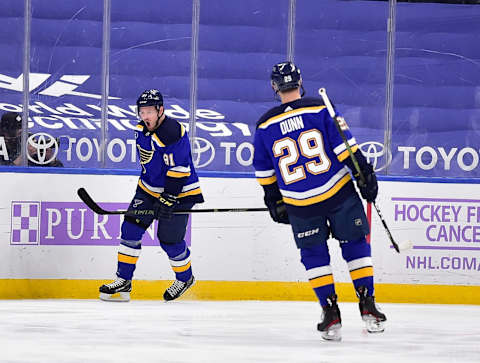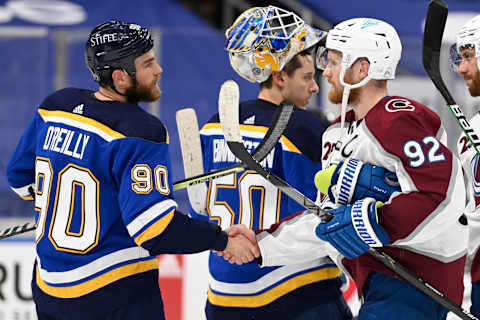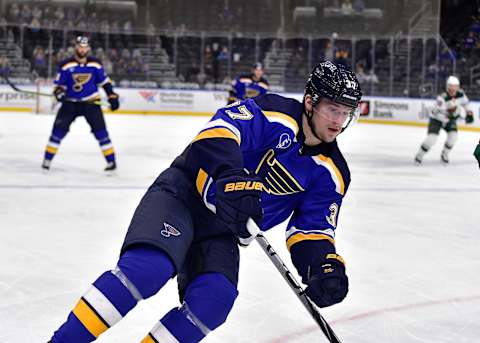St. Louis Blues Pros And Cons Of Trading Vladimir Tarasenko

What strange times we live in, my friends. Just over 24 months ago, St. Louis Blues fans were having the time of their lives, celebrating the team’s first Stanley Cup victory.
Now, in a post-pandemic era, apparently nobody went to the Costanza school of Serenity Now, Insanity later. We have people calling for the coach’s job, a vocal minority that wants to blow up the entire roster and the team’s best scorer apparently wants out.
While the the current situation remains that trading Tarasenko is not in the team’s best interest, even those that want to keep the star have to concede that it is probably more likely he is gone than staying. It is a sad state of affairs, but that’s the heart-breaking business of professional sports.
With that in mind, as with everything in sports, there are benefits and drawbacks of just about every situation – pros and cons, if you will. Fans of this page are used to this in regards to postgame reaction, trying to find the good and the bad of 82-plus games a year.
It’s not often you need to take a look at potential trades like this one. More often than not, you’re doing a postmortem on the deal instead of thinking about it ahead of time.
Nevertheless, let’s discuss the pros and cons of the Blues possibly trading Tarasenko.

Cons: Rebound
The main thought process going through social media is that Tarasenko is done. His shoulder is too badly damaged and he will never again regain the form that made him one of the most consistent scorers in the league.
However, this line of thinking is foolish and not well thought out. People look at simple goal totals and say Tarasenko only has seven goals the last two seasons. Seriously?
He had three goals in 10 games in 2019-20, prior to getting hurt. That was not setting the world on fire, but that averages out to 25 goals in a full season. Tarasenko was always known for hitting a hot streak, which would have put him on pace for his normal 30.
With that in mind, we are basing his apparent demise on 24 games, coming off a second shoulder surgery – the bubble injury does not count because the entire team played horribly. I implore those of you who have not suffered shoulder problems to think about what you are asking of someone when you think they should still score a bunch of goals after two surgeries and not playing hockey for almost two years.
This is common among fans. The majority of Blues fans were ready to jettison Jay Bouwmeester into the wild before the 2018-19 season. He had been a shell of his former self, but he had not fully recovered from a hip surgery.
We saw what he was capable of when fully healthy. If not for Bouwmeester, the St. Louis Blues don’t even reach the Stanley Cup Final. His defensive play and ability to shut down the opposition’s top lines was invaluable.
Are we so ready to assume, based on 24 games, that Tarasenko does not have that rebound left in him? St. Louis doesn’t have a good track record of making those decisions.
Brett Hull, Brendan Shanahan, TJ Oshie, Rod Brind’Amour, Doug Gilmour, Scott Stevens and 33 other players went on to win Stanley Cups after the Blues sent them away. It used to be a joke that your career would take a turn for the better after the Blues traded you.
If Tarasenko is fully healthy and actually angry with his treatment by the franchise, I would put money down on him hitting 30-plus goals with another team. That just doesn’t look good.

Pros: Cap space
We can talk all we want about what can you get in return, what’s a fair return and all that. The bottom line is, if you do trade Tarasenko, you’re looking to get the full $7.5 million in cap space freed up.
There are rumblings that the St. Louis Blues might have to retain some of the salary to make a deal work. To me, that’s a no go. One of the only benefits of trading him away is if you get that full amount of space to work with.
The Blues are already up near the cap. Give or take, they have a little over $17 million in space for 2021-22.
However, if you actually look into CapFriendly, that $17 million does not include Oskar Sundqvist, who is still listed on LTIR. His salary drops that free space to roughly $15 million, again give or take.
$15 million sounds great, but that has to cover seven roster spots. That averages out to $2 million per spot.
Your roster won’t be very good if you’re full of guys only making $2 million. So, you would need the entirety of Tarasenko’s cap space to be free to make legitimate moves for bigger guys.
If you want to make a splash, you can eat up the full $7.5 million and take up a portion of your $15 million on one, bigger name player. You can also go with quantity over quality and spread that Tarasenko money out on two players while you use up the rest of the money to give raises to the appropriate players out of your own free agent pool.
In this situation, much of the money issue would depend on what you got in return. Do you want only draft picks and prospects to keep the entire salary freed up or do you want an NHL player in return, in which case your flexibility is lessened, but you have a proven commodity.
Issues for Doug Armstrong to wrestle with.

Cons: No FA’s fit the bill
Springboarding off the question of what you get in return for the trade, you almost need to get some sort of proven, NHL talent in return for Tarasenko. That’s because none of the pending free agents fit all the categories Tarasenko does.
There are players available that might give you similar offensive production, such as Gabriel Landeskog. However, if he slips away from Colorado and hits the open market, he is going to cost more than Tarasenko currently does.
There are players available that will cost you what Tarasenko earns, or maybe even slightly less. They’re not going to get you 30 goals, however.
The NHL has tons of contracts out there with guys getting paid $6 million or more and their goal totals are in the teens. That’s not a good enough value.
Another issue is the amount of aging players available in the 2021 free agent class. Many of the big names available are in their 30’s, which is a gray area of still having a few good years left or being past your prime.
Lots of names are thrown out, but few, if any are the same package Tarasenko is. People complain about Tarasenko’s physicality or defensive ability, but apparently think Mike Hoffman is better in any of those areas? Hoffman is also two years older.
Brandon Saad is a year younger, but has not scored as many points nor goals as Tarasenko. He did hit 31 goals once, but that was immediately upon joining Columbus when he was basically giving the middle finger to Chicago for letting him go (which circles back to the con of Tarasenko having a rebound year).
Alex Ovechkin still seems capable of scoring 30-plus goals, but he’s 36 and making $9.5 million. He’s not going to take a discount anywhere besides Washington.
Tarasenko is more physical than given credit for. He’s more consistent in terms of goals scored than any player other than Ovechkin in non-pandemic seasons. He’s also still in the prime age of his career. We can argue about physical prime due to the shoulder, but he’s still got plenty of hockey left if he’s healthy.

Pros: Chance for prospects
One of the other potential benefits of sending Tarasenko away is forcing the coaching staff to elevate prospects, or at least evaluate them harder. With no fall back of a star scorer returning from injury on the horizon, you’d almost be forced to put some of these young players in prominent rolls and top-nine spots.
Jordan Kyrou, Klim Kostin and Robert Thomas all come to mind. Each of them need to take some big steps in 2021-22 to further their individual progress and the pressure cooker of needing to replace proven production might draw more out of them.
While I claim the evidence is circumstantial, it did seem as though Kyrou regressed when Tarasenko came back. The confident player from the start of the year became deferential and indecisive. Perhaps he could elevate himself to a 25 goal scorer, or more, if he didn’t feel the weight of his subconscious telling him to pass to the big gun.
While he is still young at 22, we’ve heard about Kostin for years now. The Blues have to figure out what he will be at the NHL level, if anything. If he’s only a third-line player, so be it, but we cannot keep putting it off until next year. Eventually, you can only learn or prove so much in the minors before you need to be given a real look.
In the absence of Tarasenko, Kostin would only be denied a top-nine spot if the Blues went crazy and brought in a bunch of wingers during the offseason. Kostin is not going to slide right into Tarasenko’s spot on the top line, but any gap in the top six causes shifting among the other lines and gaps that need filling.
Similarly, some might wonder why the absence of a winger would do anything for Thomas. The answer is, depending on who you bring in via trade or free agency, if you are thin on wing, you absolutely have to move Braden Schenn to the wing.
This would open up the number two center spot. Thomas has not earned a top-two center role yet, but he’s also too talented to be on the third line. Maybe giving him a full 82-games in the top six would force more out of him.
The argument can be made that losing depth on the wing might hurt Thomas, with nobody to pass to, but wingers are easier to find than centers. Similarly to Kostin, the Blues need to find out what Thomas is going to be. If he’s not a second line center, that frees him up to be trade bait or given more definitive roles that don’t focus as much on offense.
Next. Blame the pandemic, not the coaching staff. dark
Personally, I still maintain the cons outweigh the pros, but nobody in the Blues organization is asking me. The truth is the if Tarasenko is gone, the Blues have cap flexibility and some of their younger players might grab that brass ring.